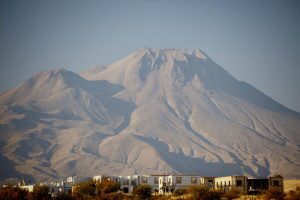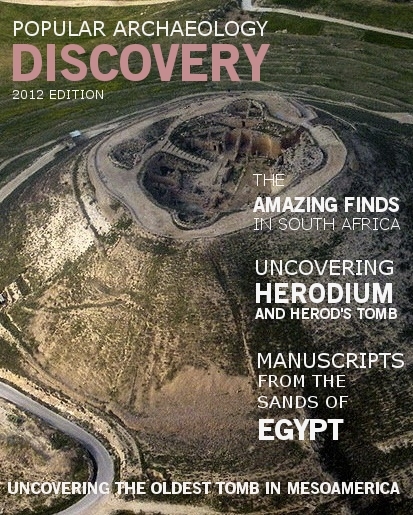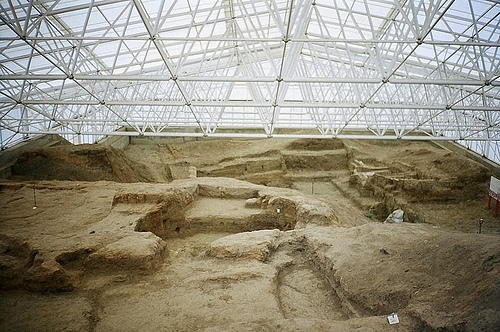
First discovered and excavated in the 1960’s by British archaeologist James Mellaart, the world-famous 9,000-year-old Neolithic site of Catälhöyuk in Central Anatolia, Turkey, has provided a unique window on the lives of humans at the transition from hunter-gatherer to settled agriculture societies. Among the spectacular finds was a mural or wall-painting dated to about 6600 BCE and described by its discoverer and others as depicting a volcanic eruption. Arguably regarded as the first map or graphical representation of a landscape, it featured “a rendering of a mountain with two peaks with the cell-like patterns representing a plan view of a village with a general layout of the houses similar to that of Catälhöyuk and other nearby Neolithic settlements”……”with the summit region showing ‘‘falling volcanic ‘bombs’ or large semiliquid lava.’’*
This description or interpretation has been contested, however, as critics have maintained that there has been little or no geologic evidence for an explosive volcanic eruption in the area contemporaneous with the age of the site, and other scholars have descibed the painting as representing a “leopard skin with its extremities cut off”.*
Now, new volcanic rock dating suggests the mural date may have overlapped with the date of an eruption from the nearby Hasan Dagi volcano. Led by Axel Schmitt from the University of California Los Angeles and colleagues from other institutions, an international team of scientists analyzed rocks from the nearby Hasan Dagi volcano in order to determine whether it was the volcano depicted in the mural from ~6600 BC. To determine if Hasan Dagi was active during that time, scientists collected and analyzed volcanic rock samples from the summit and flanks of the Hasan Dagi volcano using (U-Th)/He zircon geochronology. This resulted in the first radiometric ages for a Holocene volcanic eruption in the area. The ages were then compared to the archaeological date of the mural.
They found that volcanic rock textures and ages support the interpretation that residents of Çatalhöyük may have recorded an explosive eruption of Hasan Dagi volcano. The dating of the volcanic rock indicated an eruption around 6900 BC, which closely overlaps with the time the mural was estimated to have been painted in Çatalhöyük. The overlapping timeframes thus indicate humans in the region may have witnessed this eruption.
Says Schmitt, “We tested the hypothesis that the Çatalhöyük mural depicts a volcanic eruption and discovered a geological record consistent with this hypothesis. Our work also demonstrates that Hasan Dagi volcano has potential for future eruptions.”
The sudy results are published in detail in the January 8, 2014, open access journal PLOS ONE.
__________________________________________________________________________________________
Excavations at Çatalhöyük first began under James Mellaart in 1958 and were later renewed under Ian Hodder in 1993. Ziggurat, Wikimedia Commons
__________________________
Partial support for this study comes from NSF EAR 1029193 “Facility Support: The UCLA National Ion Microprobe”. The funders had no role in study design, data collection and analysis, decision to publish, or preparation of the manuscript. No additional external funding was received for this study.
Cover Photo, Top Left: The Hasan Dagi volcano. Credit: Janet C. Harvey
Source: Adaped and edited from a press release for the Public Library of Science and relevant excerpts from the detailed study cited above.
________________________________________________________________________________________________________________________
Read about the most fascinating discoveries with a premium subscription to Popular Archaeology Magazine. Find out what Popular Archaeology Magazine is all about. AND MORE:
 On the go? Purchase the mobile version of the current issue of Popular Archaeology Magazine here for only $2.99.
On the go? Purchase the mobile version of the current issue of Popular Archaeology Magazine here for only $2.99.
And, Popular Archaeology’s annual Discovery edition is a selection of the best stories published in Popular Archaeology Magazine in past issues, with an emphasis on some of the most significant, groundbreaking, or fascinating discoveries in the fields of archaeology and paleoanthropology and related fields. At least some of the articles have been updated or revised specifically for the Discovery edition. We can confidently say that there is no other single issue of an archaeology-related magazine, paper print or online, that contains as much major feature article content as this one. The latest issue, volume 2, has just been released. Go to the Discovery edition page for more information.
Subscription Price: A very affordable $5.75 for those who are not already premium subscribers of Popular Archaeology Magazine (It is FREE for premium subscribers to Popular Archaeology). Premium subscribers should email [email protected] and request the special coupon code. Or, for the e-Book version, it can be purchased for only $3.99 at Amazon.com.





